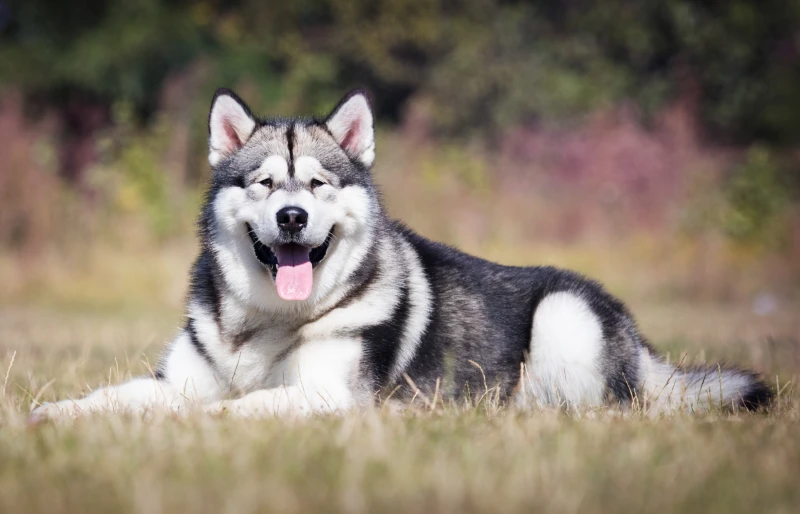12 Amazing Cane Corso Colors (with Pictures)

Updated on
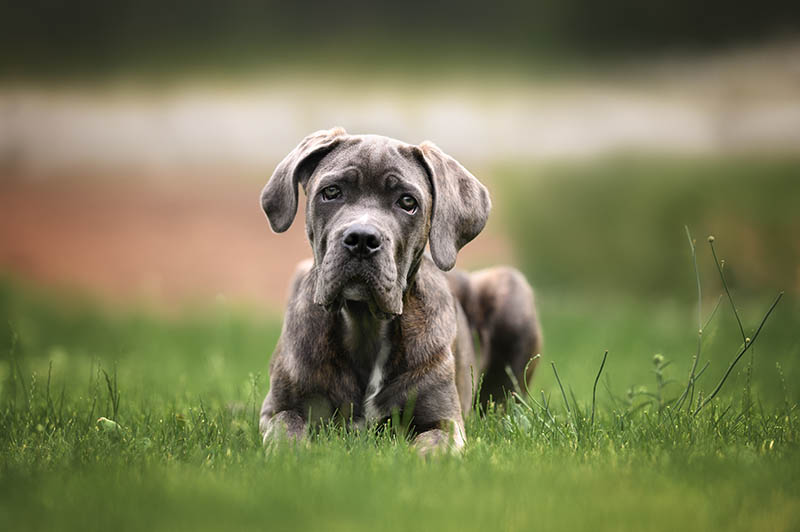
The imposing-looking Cane Corso (plural: Cani Corsi) is a fierce protector with a soft heart. This working dog has a short, double-layered coat that is low shedding and low maintenance. One of the most notable physical traits of the breed is the stunning array of colors that their coat may be.
Cani Corsi can be born with any one of 12 beautiful coat colors. Read on to discover what the 12 amazing Cane Corso colors are.
The 7 AKC Recognized Cane Corso Colors
For competition purposes, not all of 12 colorways of the Cane Corso are recognized by the American Kennel Club (AKC). We’ll start by taking a look at the seven officially recognized colors.
1. Black
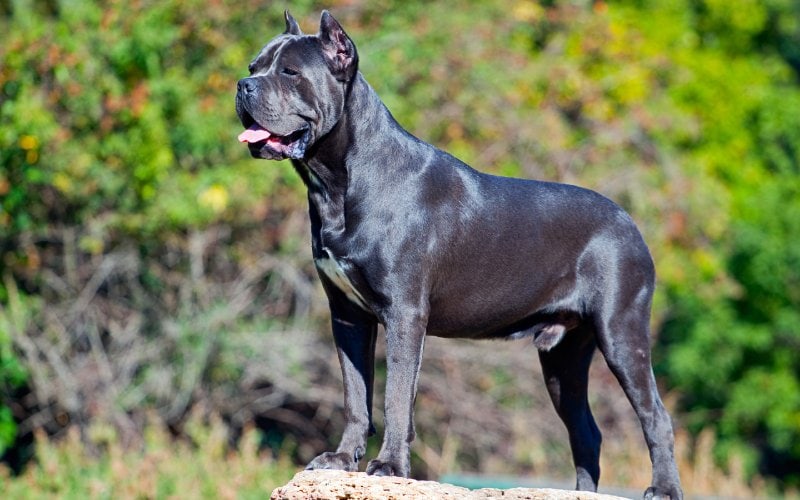
Arguably the most menacing appearing color, black Cani Corsi are also the most common and most popular. If one of the reasons for choosing a Cane Corso to join the family is for protection, then a black one will be extra intimidating.
The color results from a dominant gene, and therefore, only requires one copy from either the male or female parent.
For competition purposes, they are allowed to have a white patch on certain parts of their body—for example, the chest or chin.1 White hairs or a white patch in the wrong place is grounds for disqualification. However, if competition is not on your agenda, your Cane Corso can sport white spots galore and it will make not an iota of difference to its splendid countenance!
2. Black Brindle
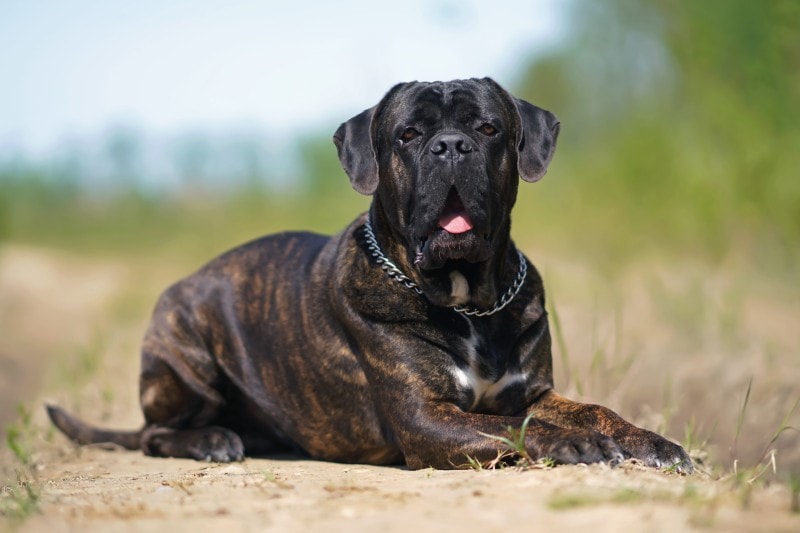
The black brindle Cane Corso is a handsome guy or gal and can look just as scary as a pure black one. They have a variably brown to red based coat color with the trademark brindle “tiger stripes” in black.
In days gone by, when the Cane Corso was used as a hunting dog, the black brindle coloration was favored due to it offering more effective camouflage.
There is a mistaken belief in some circles that the brindle color pattern is due to a genetic mutation, which may result in other conditions. This is entirely false, and brindle dogs are entirely normal and healthy. Some colors are a result of genetic mutations and do place dogs at higher risk of certain health conditions. These will be discussed later on.
3. Gray

Gray is a particularly attractive hue on a Cane Corso. It can give them the appearance of a sleek and shiny tank or an imposing granite statue! This color results when two recessive black genes—one from each black parent—combine to express this dilute phenotype. They don’t have a black mask—that is, a darker muzzle.
Gray Cani Corsi are also very popular, but because of the genetics involved, they are rarer.
A gray Cane Corso may change color as it ages. They can become lighter or darker or even develop brindling. As with the black variation, they can also exhibit a white patch on some parts of their body. The same AKC rules regarding white patches on black dogs apply to gray dogs.
4. Gray Brindle

The very attractive gray brindle coat pattern is the rarest brindle of them all. For a gray brindle to occur, there not only needs to be a pair of recessive color genes present, but also the gene for brindling. These doggies have a reddish-brown base coat with gray brindle stripes. If they have a black mask, then you know that they are not a true gray brindle, but rather one of the other brindle colors.
Much like their black brindle counterparts, they were favored for hunting due to their superior camouflage.
5. Red
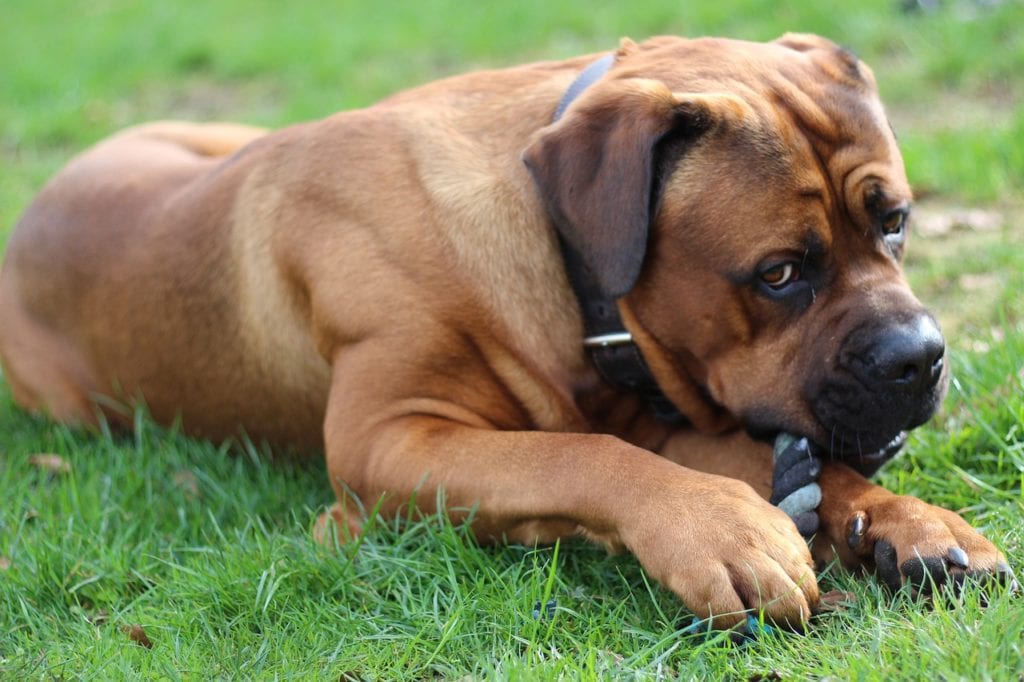
Also popular and very much in demand, the red Cane Corso color can vary in its intensity. The red color exhibits a black or gray mask similar in appearance to a German Shepherd or Rhodesian Ridgeback. The red coloration results from a dominant gene and so it is not uncommon, requiring only one gene to be present in the pair.
Additionally, some red Cani Corsi may exhibit a gray or black saddle pattern, which they may eventually outgrow. A very light red Cane Corso might be confused with a fawn-colored one, but they are separate colors, as we’ll discuss next.
6. Fawn
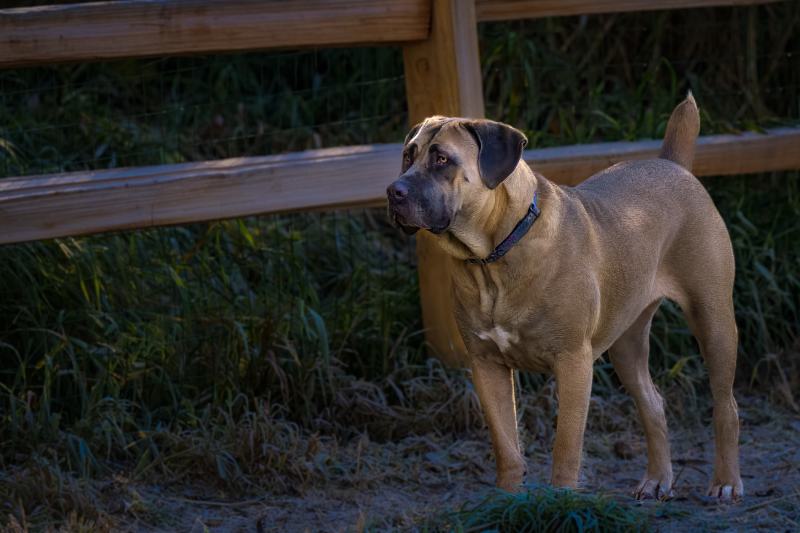
Fawn coloration results from a dilution of the gene for the red pigment. The pup needs to receive a copy of the dilute gene from both parents in order to be born fawn. Surprisingly, although one might think this could make them less common, contrarily they are one of the most common colors. This is due to their enormous popularity resulting in them being selectively bred.
A fawn Cane Corso will also have the gray or black mask that the red ones exhibits. It will always be a very light tan, sable, or cinnamon color, which are also alternative names for the color. It may sometimes be confused for a light red dog.
7. Chestnut Brindle
The chestnut brindle Cane Corso is a rarer find than the other colors. It can be confused with the black brindle. However, if you inspect the coat carefully, you will notice that the brindle “tiger stripes” are dark reddish-brown, rather than black. The base coat is also a red to brown color but will be lighter than the brindling. There can be much attractive variation in the combination of the reds and browns, resulting in a lighter or darker coat overall.
The 5 Colors Not Recognized for Competition
The following are a list of the five colors not recognized by the AKC. This may be due to the fact that these colors are frequently associated with undesirable genetic conditions.
Many of these color variations will also exhibit light-colored eyes, such as blue or yellow. These phenotypes might be beautiful, but they come at a price. Eyes like these are also grounds for immediate disqualification from competition. The reason for this ruling is to try and discourage the breeding of such colors. It seeks to strengthen the breed by rewarding healthy bloodlines and conscientious breeding, ignoring breeders and bloodlines that propagate “weak” genes.
8. Formentino
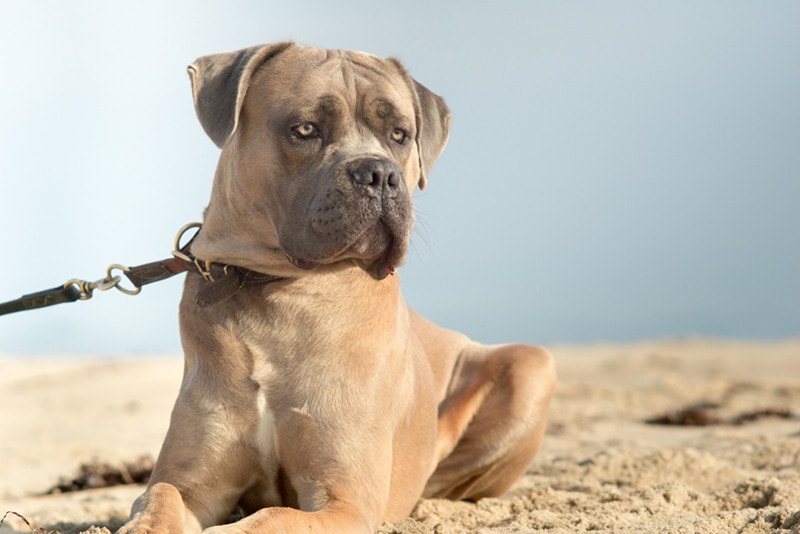
Formentino coloration results from a further dilution of the fawn gene. These doggies will be even lighter than their fawn-colored brethren. In addition, they may take on a blue-colored hue around their points, their muzzle and their saddle area. Their eyes are light-colored, appearing golden-yellow.
They may also have white patches on their chest, chin, or feet. Unfortunately, the genes that make them so strikingly good-looking also predispose them to a host of unpleasant genetic conditions, such as Color Dilution Alopecia.
9. Liver/Chocolate
There’s no doubt that the chocolate Cani Corsi, also known as liver, is a stunning colored version of this impressive hound. Unfortunately, despite having hordes of admirers, it is not officially recognized. This color predisposes dogs to undesirable genetic diseases.
The chocolate Cane Corso is usually a delicious rich shade of brown with pinkish coloration around the eyes, nose, and lips. This pink coloration is actually a lack of pigment. No black face mask is present. They also possess light-colored hazel eyes, a trademark of all dilute-colored Cani Corsi.
10. Blue
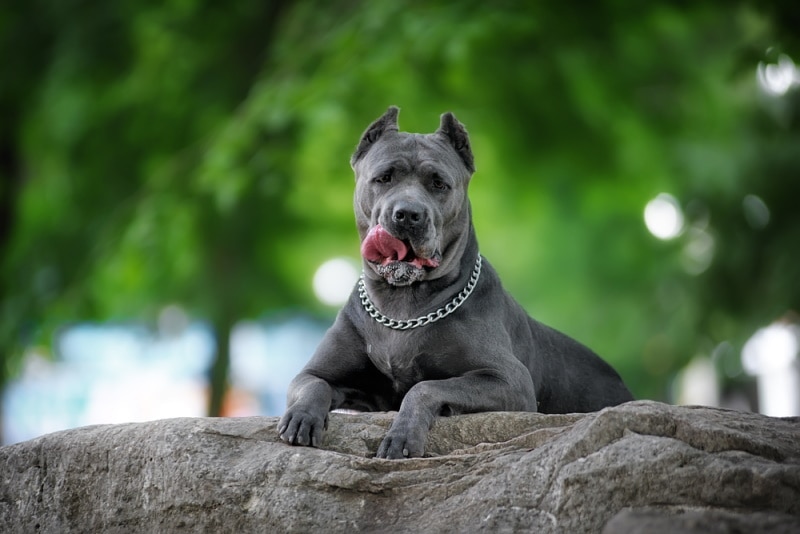
Many folks confuse the gray and blue coloration in the breed, believing them to be one and the same. The truth is the blue color results from a dilution of the gray color. Close examination will reveal the difference. Blue Cani Corsi, although similar in almost all other respects to the gray, have slight blue undertones around their noses, lips, and eyes. They are also very likely to have those beautiful, though frowned upon, light-colored eyes.
Their diluted color genes make them more susceptible to skin conditions, such as Demodectic Mange and Alopecia.
11. Isabella/Tawny
This beautiful color has a beautiful name to match. The Isabella (or tawny, as it’s also known) Cane Corso is a dilute version of the chocolate or liver color. This results in a paler brown with liver and delightful lilac undertones. It is very attractive, indeed. Unfortunately, the allure of their striking good looks can be diminished by their shorter life expectancy.
The lilac color is pronounced around their nose, eyelids, and lips—taking on a pinkish hue. Like the chocolate Cane Corso, the black face mask and points are absent. They have attractive blue or green eyes that belie their faulty genes within.
12. Straw
A straw-colored Cane Corso is very rare. Unlike the other lighter-colored versions of this breed, the straw color does not arise from a gene dilution mutation. Dogs born this color have inherited an ancient recessive gene. They are, therefore, not predisposed to the same genetic diseases of the skin that their other light-colored brethren are.
They may vary from a light yellow or golden color to appearing almost snow white. They will possess some gray or black coloration around their muzzle that is not a true mask as seen in the fawn and red Cani Corsi. They may also have the same dark color around their shoulders or saddle.
Despite their cleaner bill of health, they remain unrecognized by the AKC. These doggies are so rare that it is rumored there may only be about 20 individuals sporting the straw coloration!
Coat Color May Affect Longevity
A 2017 study verified anecdotal evidence that concluded that a Cane Corso’s coat color plays a role in their longevity. The study found that black brindle dogs are the most long-lived, followed by brindle dogs in general. Gray brindle Cani Corsi were the third long-lived. Fawn, black and gray dogs in the study did not live as long as their brindle counterparts. The remaining dilute-colored dogs in the study lived on average a year less than the solid non-dilute-colored dogs.
The below table gives a summary of the study’s findings.
| Color | Interquartile Range (Years) |
| Black brindle | 8.3–13 |
| Brindle | 7.1–11.3 |
| Gray brindle | 7–11.4 |
| Fawn | 7.7–1.2 |
| Black | 6.1–11 |
| Gray | 5.8–10.3 |
| Other | 5.5–9.2 |
Source: “Longevity of Cane Corso Italiano dog breed and its relationship with hair colour”
Conclusion
The seven main colors recognized by the AKC are associated with lower risks of unfavorable inherited diseases. This may also be true of the very rare straw-colored Cane Corso.
The remaining four colors, although pleasing on the eye, are associated with a higher-than-acceptable risk of several undesirable genetic conditions. Owning one of these could be a bit of an ethical gamble.
Nevertheless, whichever color you have fallen in love with, you still get the full package in the form of a devoted, intelligent, and companionable canine.
Featured Image Credit: otsphoto, Shutterstock




